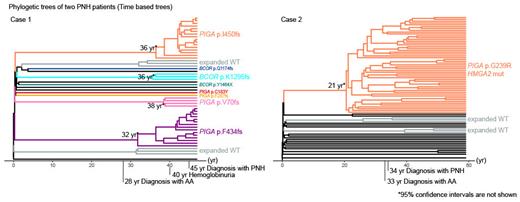Background: Patients with paroxysmal nocturnal hemoglobinuria (PNH) exhibit clonal expansion of hematopoietic cells deficient in glycosylphosphatidylinositol-anchored proteins (GPI-APs). Mutations in PIGA gene, involved in the biosynthesis of GPI-APs, result in the loss of GPI-APs from hematopoietic cells. However, PIGA mutations alone are insufficient to drive this clonal expansion. The pathogenesis of clonal expansion in PNH remains elusive, while several hypotheses or factors have been proposed, including immune attacks with concomitant aplastic anemia (AA) or additional mutations offering intrinsic growth advantage. Recently high-sensitivity flow cytometry and next-generation sequencing have allowed us to evaluate the clonal dynamics and architecture more precisely. The method has the potential to clarify the trajectories of PIGA mutated clones before the significant clonal expansion or the diagnosis, thereby to gain insight into the pathogenesis of the clonal expansion in PNH.
Methods: To estimate the trajectories of PIGA-mutated clones, we constructed phylogenetic trees using whole genome sequencing (WGS) data of single cell-derived colonies of bone marrow samples from two PNH patients (53 colonies for Case 1 and 75 for Case 2). We used the targeted-sequencing and exome sequencing to detect driver mutations after isolating GPI-deficient and GPI-positive cells using flow cytometry.
Results: Case 1 was diagnosed with AA at the age of 28. He developed hemoglobinuria at the age of 40 and was diagnosed with PNH at the age of 45. Bone marrow and peripheral blood samples were collected when he was 47 years old. The PNH clone sizes in granulocytes and red blood cells were 88.7% and 46.1%, respectively. Targeted-sequencing revealed six PIGA mutations in GPI-deficient cells and three BCOR mutations in GPI-positive cells. Case 2 was diagnosed with AA at the age of 33 and with PNH at the age of 34. Bone marrow and peripheral blood samples were collected when she was 59 years old. The PNH clone sizes in granulocytes and red blood cells were 98.6% and 96.3%, respectively. We previously identified chromosomal abnormalities in chr12, with the breakpoint located in an HMGA2 gene (Inoue et al. Blood. 2006). Targeted-sequencing detected no other driver mutations than single PIGA mutation and the HMGA2 mutation.In Case 1, Phylogenetic tree analysis constructed with WGS of single cell-derived colonies revealed multiple PIGA-mutated and BCOR-mutated clones that expanded independently of each other. All BCOR-mutated clones were identified in the GPI-positive population. In Case 2, all PIGA-mutated clones harbored the HMGA2 mutation, while no GPI-positive populations acquired the HMGA2 mutation.In both cases, the numbers of passenger single nucleotide variants per year were higher in PIGA-mutated clones than in PIGA-unmutated clones (16 vs. 11 mutations/year for Case 1 and 14 vs. 12 for Case 2). Assuming that variant acquisition rates per cell division are similar in both clones, the result suggests that PIGA-mutated clones had growth advantage against PIGA-unmutated clones.The acquisition of PIGA mutations was estimated to have occurred more than ten years prior to the PNH diagnosis. In Case 1, following the AA diagnosis, both PIGA-mutated clones and BCOR-mutated clones started expansion simultaneously, which suggests an association with immune attacks. Interestingly, even wild type clones expanded after AA diagnosis, suggesting bottle-neck effects of post-AA hematopoietic recovery. In Case 2, PIGA-mutated clones began expanding more than ten years before the AA diagnosis. Either a subclinical immune attack that might have existed before the diagnosis of clinical AA or the concomitant HMGA2 mutation conferred survival advantage for PIGA-mutated clones in Case 2.
Conclusions: This estimation of the trajectories of the PIGA-mutated clone indicates that the pathogenesis of clonal expansion exhibits heterogeneity between two PNH patients.
Disclosures
Ueda:Alexion: Consultancy, Honoraria, Membership on an entity's Board of Directors or advisory committees, Speakers Bureau; Asahi Kase: Consultancy; Chugai: Consultancy, Honoraria, Research Funding; Janssen: Consultancy; Novartis: Consultancy, Membership on an entity's Board of Directors or advisory committees, Speakers Bureau; Sanofi: Consultancy, Membership on an entity's Board of Directors or advisory committees, Speakers Bureau; SOBI: Consultancy, Honoraria. Nishimura:Alexion, AstraZeneca Rare Disease: Honoraria, Membership on an entity's Board of Directors or advisory committees, Research Funding; Chugai Pharmaceutical Co., Ltd: Membership on an entity's Board of Directors or advisory committees; Roche: Membership on an entity's Board of Directors or advisory committees. Hosen:Otsuka Pharmaceutical: Research Funding; CHUGAI PHARMACEUTICAL CO., LTD.: Research Funding; TEIJIN LIMITED: Research Funding; Kyowa Hakko Kirin Co., Ltd.: Research Funding; Eisai Co., Ltd.: Research Funding; ONO PHARMACEUTICAL CO., LTD.: Research Funding; Nippon Shinyaku Co., Ltd.: Research Funding; MOCHIDA PHARMACEUTICAL CO.,LTD.: Research Funding; Shionogi Pharma Co., Ltd.: Research Funding; ASAHI KASEI PHARMA CORPORATION: Research Funding. Nannya:Daiichi Sankyo Company Limited: Research Funding; Amelieff Corporation: Speakers Bureau; Otsuka Pharmaceutical Co., Ltd: Speakers Bureau.


This feature is available to Subscribers Only
Sign In or Create an Account Close Modal